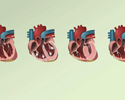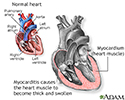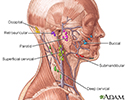Myocarditis
Inflammation - heart muscle
Myocarditis is inflammation of the heart muscle.
The condition is called pediatric myocarditis when it occurs in children.
Pediatric myocarditis
Pediatric myocarditis is inflammation of the heart muscle in an infant or young child.

Causes
Myocarditis is an uncommon disorder. Most of the time, it is caused by an infection that reaches the heart.
When you have an infection, your immune system produces special cells to fight off disease. If the infection affects your heart, the disease-fighting cells enter the heart. However, the chemicals made by these cells can also damage the heart muscle. As a result, the heart can become thick, swollen, and weak.
Many cases are caused by a virus that reaches the heart. These can include the influenza (flu) virus, coxsackievirus, parovirus, cytomegalovirus , adenovirus, and others.
Cytomegalovirus
Cytomegalovirus (CMV) infection is a disease caused by a type of herpes virus.

It may also be caused by bacterial infections such as Lyme disease, streptococcus, mycoplasma, and chlamydia .
Chlamydia
Chlamydia is an infection. It is caused by the bacteria Chlamydia trachomatis. It is most often spread through sexual contact.

Other causes of myocarditis include:
- Reactions to certain medicines, such as certain chemotherapy drugs
- Exposure to chemicals in the environment, such as heavy metals
- Infections due to fungus or parasites
- Radiation
- Autoimmune disorders that cause inflammation throughout the body
Sometimes the exact cause may not be discovered.
Symptoms
There may be no symptoms. Symptoms may be similar to the flu. If symptoms occur, they may include:
-
Chest pain that may resemble a
heart attack
Heart attack
Most heart attacks are caused by a blood clot that blocks one of the coronary arteries. The coronary arteries bring blood and oxygen to the heart. ...
 ImageRead Article Now Book Mark Article
ImageRead Article Now Book Mark Article - Fatigue or listlessness
-
Fever
and other signs of infection including headache, muscle aches, sore throat, diarrhea, or rashes
Fever
Fever is the temporary increase in the body's temperature in response to a disease or illness. A child has a fever when the temperature is at or abov...
 ImageRead Article Now Book Mark Article
ImageRead Article Now Book Mark Article - Joint pain or swelling
- Leg swelling
- Pale, cool hands and feet (a sign of poor circulation)
- Rapid breathing
- Rapid heart rate
Other symptoms that may occur with this disease:
-
Fainting
, often related to irregular heart rhythms
Fainting
Fainting is a brief loss of consciousness due to a drop in blood flow to the brain. The episode most often lasts less than a couple of minutes and y...
Read Article Now Book Mark Article -
Low urine output
Low urine output
Decreased urine output means that you produce less urine than normal. Most adults make at least 500 ml of urine in 24 hours (a little over 2 cups)....
 ImageRead Article Now Book Mark Article
ImageRead Article Now Book Mark Article
Exams and Tests
Myocarditis can be hard to diagnose because the signs and symptoms often mimic those of other heart and lung diseases, or a bad case of the flu.
The health care provider may hear a rapid heartbeat or abnormal heart sounds while listening to the child's chest with a stethoscope. A physical exam may detect fluid in the lungs and swelling in the legs in older children.
Rapid heartbeat
Palpitations are feelings or sensations that your heart is pounding or racing. They can be felt in your chest, throat, or neck. You may:Have an unpl...

There may be signs of infection, including fever and rashes.
A chest x-ray can show enlargement (swelling) of the heart. If the provider suspects myocarditis based on the exam and chest x-ray, an electrocardiogram may also be done to help make the diagnosis.
Chest x-ray
A chest x-ray is an x-ray of the chest, lungs, heart, large arteries, ribs, and diaphragm.

Electrocardiogram
An electrocardiogram (ECG) is a test that records the electrical activity of the heart.

Other tests that may be needed include:
- Blood cultures to check for infection
- Blood tests to look for antibodies against viruses or the heart muscle itself
- Blood tests to check liver and kidney function
- Complete blood count
- Heart biopsy (the most accurate way to confirm the diagnosis, but not always needed)
- Special tests to check for the presence of viruses in the blood (viral PCR)
Treatment
Treatment is aimed at the cause of the problem, and may involve:
- Antibiotics to fight bacterial infection
- Medicines called steroids to reduce swelling
- Intravenous immunoglobulin (IVIG), a medicine made of substances (called antibodies) that the body produces to fight infection, to control the inflammatory process
- Diuretics to remove excess water from the body
- Low-salt diet
- Reduced activity
If the heart muscle is weak, your provider will prescribe medicines to treat heart failure. Abnormal heart rhythms may require the use of other medicines. You may also need a device such as a pacemaker, or implantable cardioverter-defibrillator's to correct an irregular heartbeat. If a blood clot is in the heart chamber, you will also receive blood thinning medicine.
Rarely, a heart transplant may be needed if the heart muscle has become very weak or you have other health problems.
Outlook (Prognosis)
The outcome can vary, depending on the cause of the problem and a person's overall health. Some people may recover completely. Others may have lasting heart failure.
Possible Complications
Complications may include:
-
Cardiomyopathy
Cardiomyopathy
Cardiomyopathy is disease in which the heart muscle becomes weakened, stretched, or has another structural problem. It often occurs when the heart c...
 ImageRead Article Now Book Mark Article
ImageRead Article Now Book Mark Article -
Heart failure
Heart failure
Heart failure is a condition in which the heart is no longer able to pump oxygen-rich blood to the rest of the body efficiently. This causes symptom...
 ImageRead Article Now Book Mark Article
ImageRead Article Now Book Mark Article -
Pericarditis
Pericarditis
Pericarditis is a condition in which the sac-like covering around the heart (pericardium) becomes inflamed.
 ImageRead Article Now Book Mark Article
ImageRead Article Now Book Mark Article
When to Contact a Medical Professional
Call your provider if you have symptoms of myocarditis, especially after a recent infection.
Seek medical help right away if:
- Your symptoms are severe.
-
You have been myocarditis, and you have increased
chest pain
,
swelling
, or
breathing problems
.
Chest pain
Chest pain is discomfort or pain that you feel anywhere along the front of your body between your neck and upper abdomen.
 ImageRead Article Now Book Mark Article
ImageRead Article Now Book Mark ArticleSwelling
Swelling is the enlargement of organs, skin, or other body parts. It is caused by a buildup of fluid in the tissues. The extra fluid can lead to a ...
 ImageRead Article Now Book Mark Article
ImageRead Article Now Book Mark ArticleBreathing problems
Breathing difficulty may involve:Difficult breathingUncomfortable breathingFeeling like you are not getting enough air
 ImageRead Article Now Book Mark Article
ImageRead Article Now Book Mark Article
Prevention
Treat conditions that cause myocarditis promptly to reduce the risk.
References
Cooper LT, Knowlton KU. Myocarditis. In: Mann DL, Zipes DP, Libby P, Bonow RO, Braunwald E, eds. Braunwald's Heart Disease: A Textbook of Cardiovascular Medicine . 10th ed. Philadelphia, PA: Elsevier Saunders; 2015:chap 67.
Knowlton KU, Narezkina A, Savoia MC, Oxman MN. Myocarditis and pericarditis. In: Bennett JE, Dolin R, Blaser MJ, eds. Mandell, Douglas, and Bennett's Principles and Practice of Infectious Diseases . 8th ed. Philadelphia, PA: Elsevier Saunders; 2015:chap 86.
McKenna WJ, Elliott P. Diseases of the myocardium and endocardium. In: Goldman L, Schafer AI, eds. Goldman's Cecil Medicine . 25th ed. Philadelphia, PA: Elsevier Saunders; 2016:chap 60.
-
Cardiomyopathy overview
Animation
-
Myocarditis - illustration
Myocarditis is inflammation and weakness of the heart muscle usually caused by a viral infection that reaches the heart, such as the influenza (flu) virus, Coxsackie virus, and adenovirus. Myocarditis can damage the heart muscle causing it to become thick and swollen. This leads to symptoms of heart failure. Myocarditis may also occur during or after other viral or bacterial infections such as polio, rubella, Lyme disease, and others.
Myocarditis
illustration
-
Heart, section through the middle - illustration
The interior of the heart is composed of valves, chambers, and associated vessels.
Heart, section through the middle
illustration
-
Heart, front view - illustration
The external structures of the heart include the ventricles, atria, arteries and veins. Arteries carry blood away from the heart while veins carry blood into the heart. The vessels colored blue indicate the transport of blood with relatively low content of oxygen and high content of carbon dioxide. The vessels colored red indicate the transport of blood with relatively high content of oxygen and low content of carbon dioxide.
Heart, front view
illustration
-
Lymph tissue in the head and neck. - illustration
Lymph nodes play an important part in the body's defense against infection. Swelling might occur even if the infection is trivial or not apparent.
Lymph tissue in the head and neck.
illustration
-
Myocarditis - illustration
Myocarditis is inflammation and weakness of the heart muscle usually caused by a viral infection that reaches the heart, such as the influenza (flu) virus, Coxsackie virus, and adenovirus. Myocarditis can damage the heart muscle causing it to become thick and swollen. This leads to symptoms of heart failure. Myocarditis may also occur during or after other viral or bacterial infections such as polio, rubella, Lyme disease, and others.
Myocarditis
illustration
-
Heart, section through the middle - illustration
The interior of the heart is composed of valves, chambers, and associated vessels.
Heart, section through the middle
illustration
-
Heart, front view - illustration
The external structures of the heart include the ventricles, atria, arteries and veins. Arteries carry blood away from the heart while veins carry blood into the heart. The vessels colored blue indicate the transport of blood with relatively low content of oxygen and high content of carbon dioxide. The vessels colored red indicate the transport of blood with relatively high content of oxygen and low content of carbon dioxide.
Heart, front view
illustration
-
Lymph tissue in the head and neck. - illustration
Lymph nodes play an important part in the body's defense against infection. Swelling might occur even if the infection is trivial or not apparent.
Lymph tissue in the head and neck.
illustration
Review Date: 2/24/2016
Reviewed By: Michael A. Chen, MD, PhD, Associate Professor of Medicine, Division of Cardiology, Harborview Medical Center, University of Washington Medical School, Seattle, WA. Also reviewed by David Zieve, MD, MHA, Isla Ogilvie, PhD, and the A.D.A.M. Editorial team.







